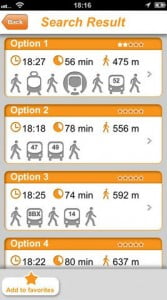Planning your schedule around public transportation times can be a drag, especially when you live in a crowded city like New York. Well, there is good news because the Israeli social transportation app, moovit, has stepped in to relieve travelers’ frustration in the Knickerbocker city. Founded in 2011, moovit is a mobile app that takes real-time user feedback about public transportation and makes it useful to a wider audience. The app already functions in over 20 metropolitan areas in the United States, Europe and Latin America, and just recently launched in the Big Apple.
The idea for moovit began when founders Yaron Evron and Roy Bick decided that they should use mobile technology to the benefit of public transportation riders in Israel. They consulted with Nir Erez, the current CEO of moovit and co-founder of the software holding group Eyron, who decided the app should go big or go home – distribute internationally or not at all. In an interview with NoCamels, Erez explains: “If we cannot dramatically change the experience of riding public transportation, the app will not be successful.”
Information by the people for the people
moovit uses crowdsourcing to gathers data, both actively reported by users and automatically collected by the app. This data is used to address what moovit believes to be all public transportation users’ basic needs: they need to know how to get from A to B at a given time, and they need to know the estimated time of arrival of a bus or train so that they can plan their travel time accordingly. With these basic needs in mind, moovit designed an app that uses several levels of data to satisfy their users with what they claim to be almost 90 percent accuracy for New York City transit.
The first source of moovit’s five sources of data points are the approximate timelines and schedules of buses and trains published by the transportation companies. Then, there is a statistical layer provided by the users of the app, which records data on time and distance from previous trips. There is also the GPS data provided by the transportation companies about the locations of the vehicles, allowing moovit to closely monitor and update ETAs. Finally, and this is where crowdsourcing comes in, the two final layers of the “moovit cake” are based on active user reports about the condition of the roads and even how many seats remain on the bus. These ratings contribute significantly to the moovit experience that allows public transportation users to better control their fate.
moovin on up to New York
moovit launched in Israel in March 2012, not only because it is the abode of the app’s founders, but also because the small country provided a simplified testing grid for the program. Then, in late October, moovit launched in 20 cities in three different continents. Already up and running in other large cities in the United States, like Los Angeles, Philadelphia, Chicago and Washington D.C., moovit now made their biggest move yet with their launch in New York.
[youtuber youtube=’http://www.youtube.com/watch?v=oga5ZMmV9Ps’]
While intuitively it might seem a daunting task to coordinate all of New York’s methods of transportation, Erez asserts that it was no more difficult than launching the app in Rome or Rio. That may be because many of the transportation companies in the United States, unlike those in Europe and Latin America, use GPS devices to track their vehicles on the go. Yet because of the diverse methods of transportation and large numbers of vehicles crowding the Big Apple, the average delay in moovit’s trip planner has been about 12 percent. Erez believes that this number will soon decline with the increase in the number of users in the city.
Despite the relative success of numerous other NYC transportation apps, like the Metropolitan Transportation Autority’s (MTA) own app Subway Time, HopStop and Google Transit, Erez believes that moovit is able to stand out among the rest. “A lot of local public transportation apps provide only rudimentary maps and trip planning devices, while moovit has been the first app to incorporate real GPS data from transportation authorities with crowdsourcing data from actual users.” Erez admits that the only app to come close to moovit’s level of transportation coordination is Google Transit except that it has yet to apply moovit’s novel crowdsourcing aspect to its technology.
Erez also addressed the fact that most of the people traveling within New York do not in fact live in the city, so what about New Jersey? Besides Israel and the Netherlands, New York is the only location on moovit’s grid to include information for suburban travelers. Erez points out that, as a result of user comments, moovit’s team expanded the New York coverage to New Jersey, so that commuters could better plan their daily haul. Erez emphasizes, however, that users should not anticipate cross-country transportation solutions, although the app is planning on expanding this year to hundreds of cities across the globe.
Sign up for our free weekly newsletter
SubscribeGo big or go home
After New York, what’s next? Erez says they plan to launch the app in the entire United Kingdom, Paris, and New South Wales over the coming months, as well as other major cities in Mexico and Latin America. moovit’s seeks to imitate the path of smartphone distribution around the world, so that public transportation users everywhere can have access to their tool.
moovit says its expansion has happened without major marketing strategies. According to Erez, moovit is entirely a mouth-to-mouth endeavo, although moovit does have some volunteers on the ground in major cities who act as their local eyes and ears.
Using gathered data to make a profit
Erez believes that these statistics on the location of users, garnered through moovit’s active and passive collection of data, could be the basis for successful marketing applications in the future. “The information moovit collects can benefit municipal authorities and ministries of transportation, as well as private companies
moovit’s seed investment came from Erez’s firm Eyron and the startup has also received an undisclosed amount from BRM Group and Gemini Ventures.
Nir Erez is also the founder and CEO of two other start-ups, ActionBase and OptimalTest, and came to moovit with extensive software and entrepreneurial experience. He received his Bachelors in Physics from Bar Ilan University and is a graduate of the Israeli Defense Forces Computer Science Academy.
Still, Erez’s biggest contribution to moovit seems to be his commitment to the influence the app has on people’s lives. Through moovit, he hopes to remodel the dismal patterns of transportation we are so used to and “drive drivers to use public transport and change the world.”
The app is available on the Apple App Store and on Google Play.
Photos: moovit | Emilio Santacoloma
Related posts

Editors’ & Readers’ Choice: 10 Favorite NoCamels Articles

Forward Facing: What Does The Future Hold For Israeli High-Tech?

Impact Innovation: Israeli Startups That Could Shape Our Future






Facebook comments